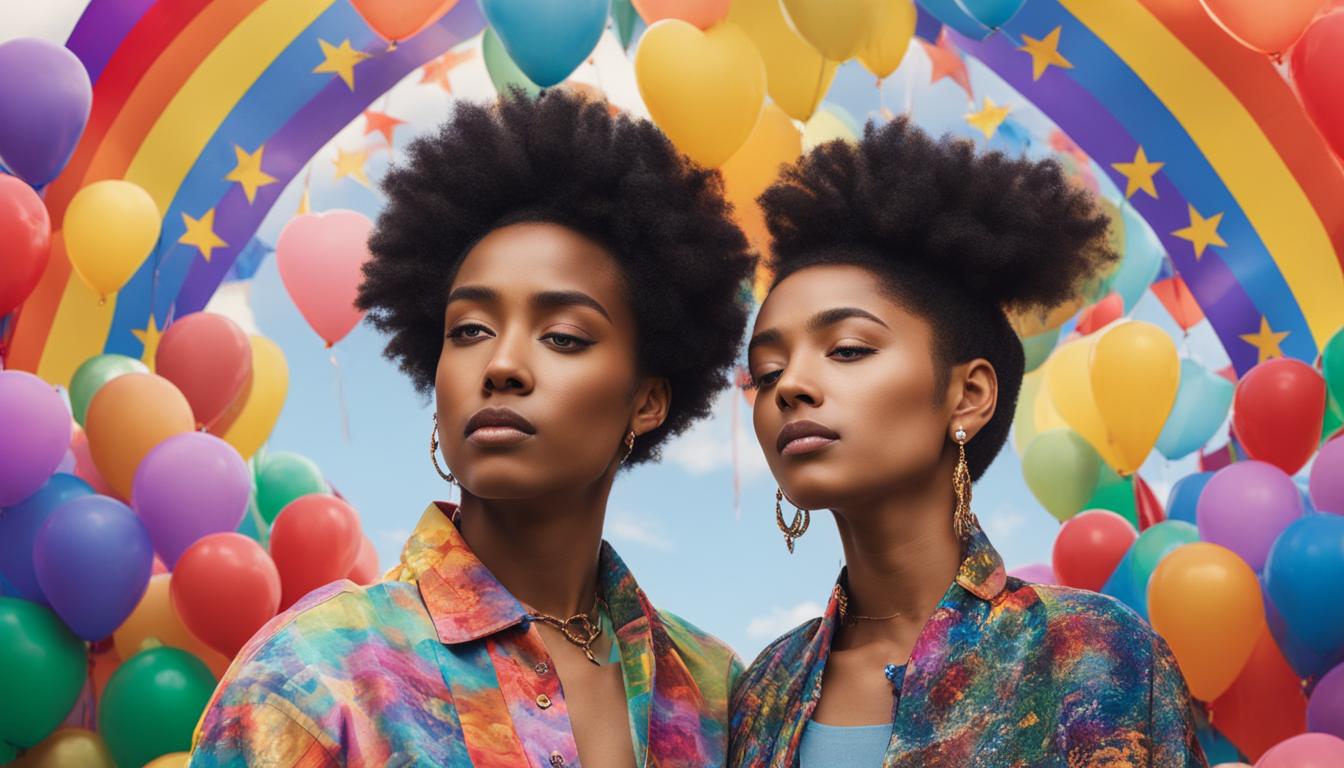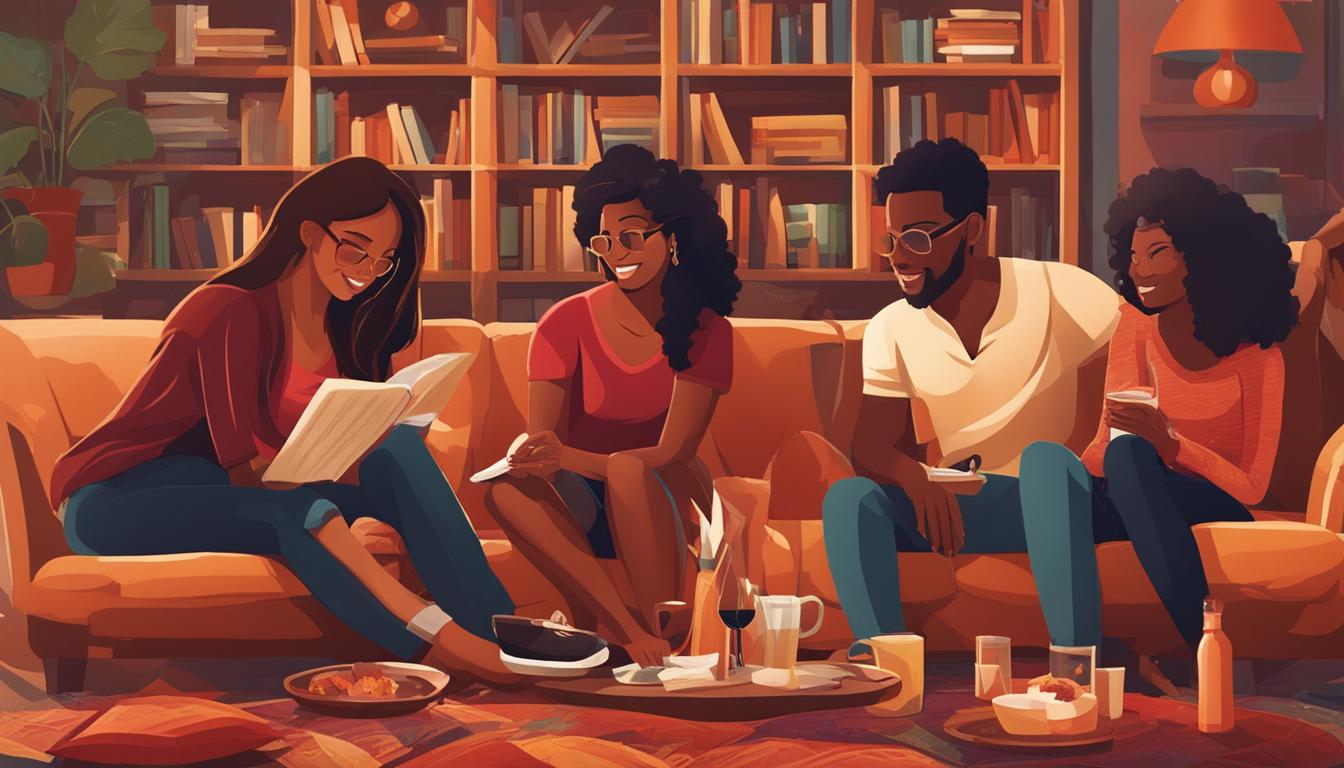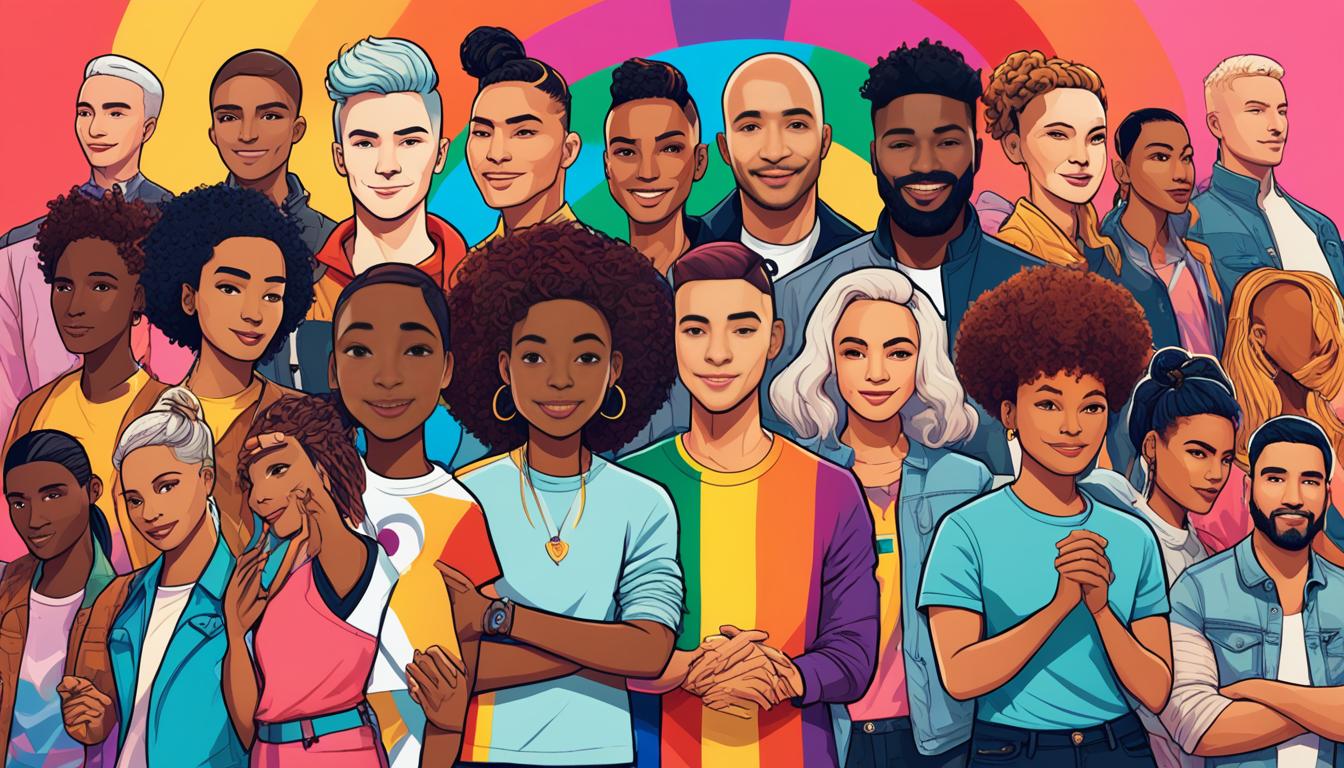Welcome to an exploration of queer platonic relationships, also known as QPRs. In this article, we will delve into the intricacies of these non-romantic partnerships, the dynamics they entail, and their significance within the LGBTQ+ community.
Queer platonic relationships challenge traditional notions of companionship and redefine the meaning of love and connection. They encompass intimate friendships that go beyond the boundaries of typical friendships, offering a deep emotional bond, commitment, and validation, similar to that found in romantic relationships.
Originating within the asexual and aromantic communities, queerplatonic relationships have gained recognition in mainstream discussions. These relationships are characterized by a level of emotional intimacy and commitment that surpasses societal expectations of platonic friendships. The concept of queerplatonic relationships has also been embraced by the polyamorous and non-monogamous communities.
While there is no fixed structure for queerplatonic relationships, they can involve shared living arrangements, financial entanglement, co-parenting, and more. Physical affection, such as hand-holding or cuddling, is not uncommon, as it goes hand in hand with the emotional connection nurtured within these relationships.
Throughout this article, we will address various aspects of queerplatonic relationships, including the terms of endearment used to describe these connections, the perceptions and discrimination they may face, and the representation of these relationships in media.
Join us in exploring the transformative nature of queerplatonic relationships and their impact on reshaping our understanding of love and partnership.
Key Takeaways:
- Queer platonic relationships challenge traditional notions of companionship and redefine love and connection.
- These relationships originated in the asexual and aromantic communities.
- Queerplatonic relationships are characterized by deep emotional bonds and a commitment similar to that of romantic relationships.
- They can involve shared living arrangements, physical affection, and other non-traditional aspects.
- Representation of queerplatonic relationships in mainstream media is still limited, but progress is being made.
The Definition of Queerplatonic Relationships
Queerplatonic relationships, as defined by C. J. DeLuzio Chasin, are non-romantic significant-other relationships of “partner status.” These relationships go beyond the boundaries of a traditional friendship and involve a stronger emotional connection. They are characterized by a level of commitment and emotional intimacy that goes beyond typical friendships.
Queerplatonic relationships challenge normative categories and are considered to be “queered” platonic relationships. From an outsider’s perspective, these relationships are often indistinguishable from romantic relationships. However, the participants themselves do not label it as romantic if they feel it is not.
These relationships offer a deeper emotional connection and provide a sense of commitment, validation, and structure, similar to a romantic relationship. They are a unique form of connection that goes beyond the traditional bounds of friendship.

Origins and Use of Queerplatonic Relationships
The term “queerplatonic relationship” emerged in the asexual and aromantic communities during the 2010s, as individuals sought a vocabulary to describe profound connections that extended beyond romance. This terminology encompasses relationships that are deeper than friendships yet remain non-romantic and non-sexual, aligning with the identities of those in the asexual and aromantic communities. Over time, the term gained recognition outside these communities and entered mainstream discourse.
Queerplatonic relationships are not exclusive to the asexual and aromantic communities. They are also present in polyamorous and non-monogamous contexts, where individuals may engage in multiple partnerships and embrace non-traditional relationship structures.

By recognizing the need for language that goes beyond romance, the asexual and aromantic communities have paved the way for the wider acknowledgment and understanding of queerplatonic relationships. These relationships challenge societal norms and expand the possibilities for human connection and intimacy.
Queerplatonic Relationship Dynamics and Structures
Queerplatonic relationships offer a unique and non-traditional approach to partnerships. Unlike traditional romantic relationships, queerplatonic relationships do not adhere to societal expectations or predefined structures. These relationships emphasize emotional connection, non-romantic intimacy, and platonic love.
In a queerplatonic partnership, individuals have the freedom to create their own dynamic that suits their needs and desires. This flexibility allows for a wide range of possibilities, such as living together, sharing finances, co-parenting, or even legally binding themselves. Queerplatonic relationships blur the lines between friendship and romance, challenging the notion that commitment and emotional connection are reserved exclusively for romantic relationships.
Though queerplatonic relationships are non-romantic, physical affection can still play a role. It is not uncommon for queerplatonic partners to engage in activities such as hand-holding, cuddling, or even kissing. These displays of physical intimacy are not rooted in romance but serve as a way to express care, comfort, and affection.
Intimacy in queerplatonic relationships extends far beyond the physical realm. Queerplatonic partners often share deep emotional bonds that involve sharing secrets, discussing future plans, and becoming involved in each other’s families. This level of emotional commitment fosters a sense of trust, support, and love that is akin to what one might experience in a traditional romantic relationship.
To maintain a healthy and fulfilling queerplatonic partnership, open communication and boundary setting are essential. Both individuals must actively engage in honest and transparent conversations to ensure that their needs, desires, and expectations are met. This may include discussing and establishing boundaries, defining the nature of their partnership, and continuously checking in with one another.
Queerplatonic relationships are not limited to monogamy and can exist within the context of polyamory or other non-traditional relationship structures. These relationships challenge societal norms and provide individuals with the freedom to form connections based on emotional compatibility and shared values rather than traditional romantic ideals.
Terms of Endearment in Queerplatonic Relationships
In queerplatonic relationships, partners have their own unique ways of expressing love and affection. These terms of endearment serve as a personal language that captures the essence of their deep emotional bond.
One playful term commonly used in queerplatonic relationships is “zucchinis.” This lighthearted term originated as a joke within the asexual and aromantic communities, highlighting the lack of appropriate language for non-romantic or non-sexual significant relationships. Calling each other “zucchinis” is a playful reminder of the unique nature of their connection.
Another endearing term used in queerplatonic relationships is “marshmallow friends.” This sweet term emphasizes the warmth, comfort, and emotional closeness experienced in these partnerships. It captures the sense of safety and support that comes from sharing a deep bond with someone who understands you on a profound level.
“Squish” is yet another term that holds significance in queerplatonic relationships. Similar to a crush, but without romantic or sexual involvement, a “squish” represents a desire for an intimate companionship that goes beyond mere friendship. It embodies the longing for a deep emotional connection and a meaningful partnership.
These terms of endearment go beyond traditional labels and allow individuals in queerplatonic relationships to express the unique dynamics and emotions they share. They serve as a reminder that love and connection can take many forms, challenging the limitations of societal expectations and embracing the depth of non-romantic partnerships.
Remember, whether you choose to use zucchinis, marshmallow friends, or create your own special term, the beauty of queerplatonic relationships lies in their ability to redefine what love and intimacy mean to you. Embrace the power of words and forge a connection that is authentic, meaningful, and true to your own unique journey.
Perceptions and Discrimination of Queerplatonic Relationships
Queerplatonic relationships disrupt societal expectations and challenge the established norms surrounding romantic and sexual partnerships. In a society that prioritizes romantic love above all else, these unique relationships often face misunderstanding, ignorance, and a lack of validation.
Amatonormativity, the societal assumption that romantic love is superior and should be the ultimate goal, marginalizes queerplatonic relationships. This normative mindset diminishes the significance of non-romantic partnerships and undermines the diverse ways in which individuals form deep connections.
The LGBTQ+ community, while striving for acceptance and inclusivity, may still struggle to fully recognize and validate the experiences of those in queerplatonic relationships. The focus on romantic and sexual relationships within the community can overshadow the importance and validity of non-romantic partnerships, leading to a lack of visibility and understanding.
Discrimination and judgment can arise from those who do not comprehend or accept non-traditional relationship structures. This can manifest as questioning the validity of queerplatonic relationships, denying their existence, or dismissing them as “just friendships.” Such discrimination further marginalizes individuals in queerplatonic partnerships, impeding their ability to form meaningful connections and hindering their emotional well-being.
It is crucial to acknowledge and validate the experiences of individuals in queerplatonic relationships. By creating a more inclusive and accepting society, we can combat discrimination and challenge societal expectations. This requires education and awareness about the diverse ways in which people form connections and the validity of non-romantic partnerships.
Representation of Queerplatonic Relationships in Media
Despite the growing awareness and acceptance of diverse relationship structures, the representation of queerplatonic partnerships in mainstream media is still limited. However, there are instances in film, television, literature, and music where characters form intense and non-romantic bonds that challenge traditional notions of companionship. These representations help to normalize and validate the experiences of individuals in queerplatonic relationships.
“We need more media representation of queerplatonic relationships to show the world that love and connection can exist beyond the boundaries of romance.” – LGBTQ+ activist
While queerplatonic partnerships may not receive the same level of attention as romantic relationships in media, their portrayal serves as a crucial step towards inclusivity and understanding. Through authentic and diverse representations, these relationships can be seen as valid and meaningful, enriching the narratives that unfold on screen, in books, and through music.
For example, in recent films like “Silver Linings Playbook” and “The Book of Life,” characters develop deep connections that transcend romance. In television, shows like “Friends” and “Sherlock” showcase friendships that blur the lines between platonic and romantic love.
Literature also explores the complexities of queerplatonic relationships. In novels like “Aristotle and Dante Discover the Secrets of the Universe” and “The Color Purple,” the characters form profound bonds that challenge societal expectations.
Music, too, has been a platform for queerplatonic representation. Songs like “Waving Through a Window” from the musical “Dear Evan Hansen” and “Happier” by Marshmello and Bastille evoke feelings of deep emotional connection and understanding that can go beyond romance.
By including queerplatonic partnerships in media, creators have the power to validate and amplify the experiences of those in non-traditional relationships. These representations help to broaden the understanding of love, intimacy, and connection, fostering a more inclusive and accepting society.

Through media representation, queerplatonic relationships can gain visibility, contributing to a more nuanced and diverse portrayal of the human experience.
Conclusion
In conclusion, queerplatonic relationships offer a unique and valuable form of companionship, redefining traditional notions of love and connection. These non-romantic partnerships go beyond typical friendships, providing individuals with deep emotional bonds, commitment, and validation.
By challenging societal expectations, queerplatonic relationships open doors to new and meaningful connections. They demonstrate that intimate friendships can be just as fulfilling and significant as romantic partnerships. It is crucial that we recognize and validate the experiences of individuals in queerplatonic relationships, fostering an inclusive and accepting society that celebrates all types of love and relationships.
As we continue to evolve and expand our understanding of love, it is important to embrace the diversity of intimate relationships, including queerplatonic partnerships. By acknowledging the value of non-romantic connections, we can create a world that respects and supports the range of experiences and emotional connections that individuals seek, regardless of societal norms.
FAQ
What are queer platonic relationships?
Queer platonic relationships, also known as QPR, are intimate partnerships that are not romantic in nature. These relationships challenge traditional notions of companionship and redefine the meaning of love and connection.
How do queerplatonic relationships differ from friendships?
Queerplatonic relationships involve a deep emotional bond that goes beyond what is typically seen in a friendship. They provide a sense of commitment, validation, and structure, similar to a romantic relationship.
Where did the concept of queerplatonic relationships originate?
The concept of queerplatonic relationships originated in the asexual and aromantic communities within the LGBTQ+ community. These relationships are often characterized by a profound emotional connection that can be even stronger than a typical friendship.
How do queerplatonic relationships challenge societal norms?
Queerplatonic relationships challenge normative categories and are considered to be “queered” platonic relationships. They are characterized by a level of commitment and emotional intimacy that goes beyond typical friendships.
Are queerplatonic relationships limited to the asexual and aromantic communities?
Queerplatonic relationships are not limited to the asexual and aromantic communities. They are also present in the polyamorous and non-monogamous communities, where individuals may have multiple partners and choose non-traditional relationship structures.
What is the structure of queerplatonic relationships?
Queerplatonic relationships do not have a fixed structure and can vary greatly depending on the individuals involved. These relationships challenge societal expectations of what a partnership should look like.
What forms of intimacy are present in queerplatonic relationships?
Although queerplatonic relationships are non-romantic, physical affection such as hand-holding, cuddling, or kissing can still be present. Intimacy in queerplatonic relationships goes beyond just sexual or romantic aspects and may involve sharing secrets, discussing future plans, and getting involved in each other’s families.
What are some terms of endearment used in queerplatonic relationships?
Some common terms used in queerplatonic relationships include “zucchinis,” “marshmallow friends,” and “squish.” These terms allow individuals to express the unique nature of their relationships and challenge traditional labels and expectations.
How are queerplatonic relationships perceived in society?
Queerplatonic relationships can be misunderstood or even ignored in a society that prioritizes romantic love. There may be a lack of validation and recognition within the wider LGBTQ+ community, and individuals may face discrimination or judgment from those who do not understand or accept non-traditional relationship structures.
Are there any representations of queerplatonic relationships in media?
While the representation of queerplatonic relationships in mainstream media is still limited, there are instances in film, television, literature, and music where characters form intense and non-romantic bonds that challenge traditional notions of companionship.
Source Links
- https://en.wikipedia.org/wiki/Queerplatonic_relationship
- https://www.gstherapycenter.com/blog/what-are-queerplatonic-partnerships
- https://lgbtqia.fandom.com/wiki/Queerplatonic_relationship


